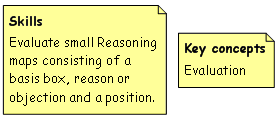The Science Of Scientific Writing Set 7 Set 7-Assessing • Second page • Third page • Fourth page • Example • Exercise 1 • Exercise 2 • Exercise 3 • Exercise 4 • Exercise 5 • Exercise 6 • Final Page Set 7.
OVERVIEW: The way to well-written science
PART I: Paragraphs and Sentences
SET A: Paragraphs: The Maps Behind Them
SET B: Paragraphs: Using Maps to Meet Readers' Expectations
SET C: Paragraphs with Something Extra: Points and Tails
SET D: The Generic Section: Expectations and Maps as Blueprints
SET E: Scientific Sections: The Methods and Results
SET F: Scientific Sections: The Discussion
SET G : Scientific Sections: The Introduction
SET H : Sentences
SET I : The Paper as a Whole
PART II: The Paper and its Sections
SET 1: Argument Parts
SET 2: Indicator Words
SET 4: Locating Arguments in Prose
SET 5: Rationale's Essay Planner
SET 6: Evidence in Arguments: Basis Boxes
Synthesis 1: Position-Early Paragraphs
Synthesis 2: Position-Final Paragraphs
Synthesis 3: Writing a Discussion I
Synthesis 4: Writing a Discussion II
Set 7 - Assessing
Looking at the use of evidence in an argument, and the quality and applicability of that evidence, is just the first step in assessing the quality of an argument. Here we will begin to see how we can assess EVERY type item box (basis, reason, objection and claim) on a simple, one branch, Rationale map.
By systematically checking every item on a map, we can better assess whether or not an argument as a whole is any good. Such evaluation is the heart of critical thinking.
In the next two sets you will ask 'should I be convinced by this argument?', and show your evaluation on a Rationale Reasoning map.

Content of this page drawn in whole or part from the Austhink Rationale Exercises with permission from Austhink.